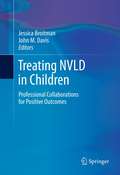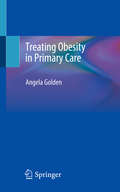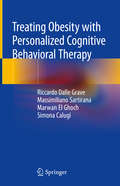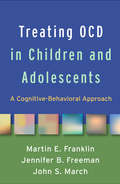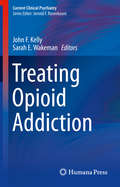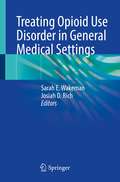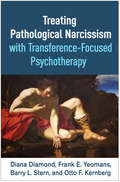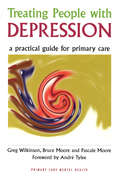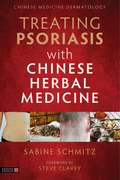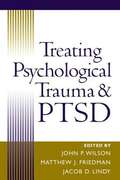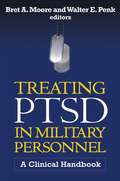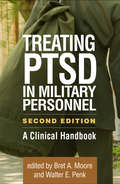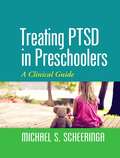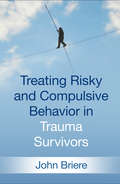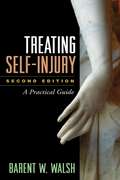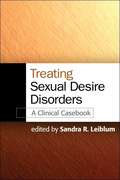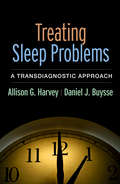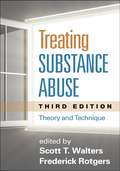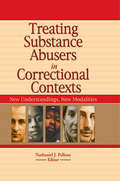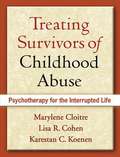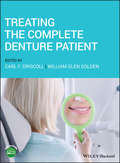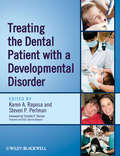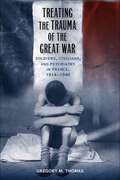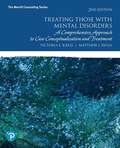- Table View
- List View
Treating NVLD in Children
by Jessica Broitman John M. DavisChildren with nonverbal learning disabilities (NVLD) have needs that can take many forms and may, over time, require consultation and collaboration with professionals from several fields. Given that multiple specialists may be involved in working with children with NVLD - as well as the array of treatment variables - even seasoned practitioners may find themselves in confusing situations. Treating NVLD in Children takes a developmental view of how the problems and needs of young people with nonverbal learning disabilities evolve and offers a concise guide for professionals who are likely to contribute to treatment. Expert practitioners across specialties in psychology, education, and rehabilitative therapy explain their roles in treatment, the decisions they are called on to make, and their interactions with other professionals. Collaborative interventions and teamwork are emphasized, as are transitions to higher learning, employment, and the adult world. Among the book's key features are: A new four-subtype model of NVLD, with supporting research.A brief guide to assessment, transmitting results, and treatment planning.Chapters detailing the work of psychologists, therapists, coaches, and others in helping children with NVLD.Material specific to improving reading, writing, and mathematics. Overview of issues in emotional competency and independent living. An instructive personal account of growing up with NVLD. Treating NVLD in Children: Professional Collaborations for Positive Outcomes is a key resource for a wide range of professionals working with children, including school and clinical child psychologists; educational psychologists and therapists; pediatricians; social workers and school counselors; speech and language therapists; child and adolescent psychiatrists; and marriage and family therapists.
Treating Obesity in Primary Care
by Angela GoldenThe latest information from the CDC demonstrates that 70% of Americans can be classified as having pre-obesity or obesity. This chronic disease is considered the cause of many other chronic diseases such as hypertension, dyslipidemia, diabetes, and nonalcoholic fatty liver disease, to name but a few of the 236 obesity associated disorders. Additionally, obesity is considered to be the cause of fourteen different types of cancers. Based on the number of people affected and the consequences of the disease, it is imperative that it is studied and treated by primary care providers. Few training programs for physicians, NPs or PAs are covering the basics of treating obesity. These fundamentals include pathophysiology, assessment of the disease, and the foundational components of treatment with eating plans, physical activity and behavioral interventions, then the supporting components of anti-obesity medications, devices and surgery. As a result, few of those currently in primary care practice have received any education in the evidence-based treatment of obesity. This book provides the reader with the education to understand the disease, the patient’s experience, and full evidence-based treatment. It also provides the opportunity to understand how to incorporate the treatment into primary care. Written by a leading expert in the field, Treating Obesity in Primary Care offers all clinicians providing primary care services the information needed to effectively treat the chronic disease of obesity.
Treating Obesity with Personalized Cognitive Behavioral Therapy
by Riccardo Dalle Grave Massimiliano Sartirana Marwan El Ghoch Simona CalugiThis book describes a novel therapy for obesity that associates the traditional procedures of weight-loss lifestyle modification with specific, individualized cognitive behavioral procedures to address some obstacles that have been indicated by recent research to influence weight loss and maintenance. The Cognitive Behavioral Therapy for Obesity (CBT-OB) can be used to treat all classes of obesity, including patients with severe comorbidities and disability associated with obesity, who are not usually included in traditional weight-loss lifestyle modification treatments. The book describes the treatment program in detail, and with numerous clinical vignettes. It also discusses involving significant others in the change process and adapting the CBT-OB for patients with severe obesity, binge-eating disorder, medical and psychiatric comorbidity, and treated with weight-loss drugs or bariatric surgery. Lastly, a chapter is dedicated to the use of digital technology with CBT-OB in order to help patients monitor their food intake and physical activity and to addressing obstacles in real time. Thanks to the description of how to apply the latest, evidence-based CBT-OB to real world settings, this volume is a valuable useful tool for all specialists - endocrinologists, nutritionists, dietitians, psychologists, psychiatrists - who deal with obesity and eating disorders.
Treating OCD in Children and Adolescents: A Cognitive-Behavioral Approach
by Martin E. Franklin Jennifer B. Freeman John S. MarchFrom foremost experts, this authoritative work offers a framework for helping children overcome obsessive–compulsive disorder (OCD) using the proven techniques of cognitive-behavioral therapy (CBT). Therapists gain knowledge and tools to engage 6- to 18-year-olds and their parents and implement individualized CBT interventions, with a focus on exposure and response prevention. In a user-friendly, conversational style, the authors provide real-world clinical guidance illustrated with vivid case examples. Purchasers get access to a Web page where they can download and print the volume's reproducible handouts in a convenient 8 1/2" x 11" size. Building on the earlier OCD in Children and Adolescents: A Cognitive-Behavioral Treatment Manual (by John March and Karen Mulle), this book reflects two decades of advances in the field; most of the content is completely new.
Treating Opioid Addiction (Current Clinical Psychiatry)
by John F. Kelly Sarah E. WakemanThis book addresses opioids and opioid use disorders from epidemiological, clinical, and public health perspectives. It covers detailed information on the nature of opioids, their effects on the human body and brain, prevention, and treatment of opioid addiction. Unlike other texts, the first section of this volume builds a strong historical, neurobiological, and phenomenological foundation for a deep understanding of the topic and the patient. The second section addresses the most challenging issues clinicians face, including pharmacological and psychosocial treatments, harm reduction approaches, alternative approaches to pain management for the non-specialist, and prescribing guidelines. Treating Opioid Addiction is a valuable resource for psychiatrists, psychologists, addiction medicine physicians, primary care physicians, drug addiction counselors, students, trainees, scholars, and public health officials interested in the effects and impact of opioids in the clinical and epidemiological context.
Treating Opioid Use Disorder in General Medical Settings
by Sarah E. Wakeman Josiah D. RichThis book is an invaluable reference for medical practitioners seeking to integrate opioid use disorder (OUD) treatment into general medical settings, including primary care, the inpatient hospital, and the emergency department. It recognizes opioid-related deaths in the United States as a significant public health crisis and fills the gap in drug use and addiction treatment knowledge for care providers.Timely and concise, opening chapters examine the history of OUD pharmacology and treatment, as well as the principles of care and treatment. Subsequent chapters analyze the shortcomings of current approaches to opioid addiction, including the high cost and low value of acute care delivered by minimally trained providers and the fixation on short-term detoxification and rehab. The book offers specific guidance for practical integration of effective opioid use disorder treatment into a range of healthcare settings. Chapters also discuss the unique complexities of caring for special populations with OUD, such as pregnant people and those involved in the criminal legal system. The book concludes with personal experience from individuals with a history of OUD. Socially conscious and practical, Treating Opioid Use Disorder in General Medical Settings serves as a crucial evidence-based resource for physicians, nurse practitioners, physician assistants, nurses, and other healthcare professionals.
Treating Pathological Narcissism with Transference-Focused Psychotherapy (Psychoanalysis and Psychological Science)
by Diana Diamond Otto F. Kernberg Frank E. Yeomans Barry L. SternFilling a crucial gap in the clinical literature, this book provides a contemporary view of pathological narcissism and presents an innovative treatment approach. The preeminent authors explore the special challenges of treating patients--with narcissistic traits or narcissistic personality disorder--who retreat from reality into narcissistic grandiosity, thereby compromising their lives and relationships. Assessment procedures and therapeutic strategies have been adapted from transference-focused psychotherapy (TFP), a manualized, evidence-based treatment for borderline personality disorder. Rich case material illustrates how TFP-N enables the clinician to engage patients more deeply in therapy and help them overcome relationship and behavioral problems at different levels of severity. The volume integrates psychodynamic theory and research with findings from social cognition, attachment, and neurobiology.
Treating People with Depression: A Practical Guide for Primary Care
by Greg Wilkinson Bruce Moore Pascale MooreThis is a revised edition of an established text on hypertension, which takes into account changes in the culture of general practice arising from the 1990 GP Contract.
Treating Psoriasis with Chinese Herbal Medicine (Revised Edition): A Practical Handbook
by Sabine SchmitzUsing a modern and practical approach, this book looks at the root cause of psoriasis from a Chinese medicine perspective. It examines in depth the most common Chinese medicine syndromes and formulas that have proved to be effective, discusses the role of the environment and emotional health and covers both internal and external applications.Containing numerous colour photographs of skin and tongue conditions, and many case studies, this practical guide shows the practitioner how to start treating their patients and provide relief. It also presents the latest research on Chinese herbs used to treat psoriasis and includes information on the creation of creams, ointments and tinctures.
Treating Psychological Trauma and PTSD
by John WilsonMuch has been learned about PTSD in the past two decades, yet many questions remain about the complex pathways by which trauma disrupts people's lives. This authoritative volume presents an innovative psychobiological framework to help clinicians and researchers better understand the myriad difficulties facing patients and navigate the array of available intervention approaches. Incorporating the latest theory and clinical research, the book provides a crucial reformulation of diagnostic criteria and treatment goals. It then brings together leading treatment experts to describe and illustrate their respective approaches, facilitating the selection and implementation of the most effective interventions for individual patients. The book first delineates a holistic, organismic model of PTSD. Particular attention is given to how the concept of allostatic load has enabled contemporary investigators to gain a more dynamic view of human stress responses and how they may go awry. Aided by clearly presented tables and charts, the volume elucidates the process by which traumatic experiences can give rise to 65 symptoms contained within five symptom clusters. Augmenting the traditional domains of PTSD symptomatology physiological disturbances, traumatic memory, and avoidance are two additional clusters dealing with frequently encountered problems with self and identity and with attachment, intimacy, and personal relationships. Contributors then provide detailed presentations of core therapeutic approaches acute posttraumatic interventions, cognitive-behavioral approaches, pharmacotherapy, group psychotherapy, and psychodynamic techniques, as well as approaches for special populations. The concluding section reviews and synthesizes all case material presented, examining which symptoms are addressed by each modality, which treatment objectives are met, and which clients are likely to be helped.
Treating PTSD in Military Personnel
by Bret A. Moore Walter E. PenkThis practical volume covers the full range of effective treatments for PTSD and discusses their implementation with service members and veterans. The focus is on how to meet this population's unique needs. From conducting a thorough assessment to choosing an appropriate psychosocial or pharmacological treatment, the expert editors and contributors clearly relate their years of experience in military contexts. The norms and values of military culture are discussed. Chapters thoroughly describe available therapies, review their strengths and limitations, and use illustrative case examples to demonstrate the treatments in action. Also addressed are clinical issues and co-occurring problems that can arise in this population, such as traumatic brain injury and substance abuse, and strategies for dealing with them
Treating PTSD in Military Personnel, Second Edition: A Clinical Handbook
by Bret A. Moore Walter E. Penk Matthew J. FriedmanThis state-of-the-science guide to assessing and treating posttraumatic stress disorder (PTSD) in active-duty service members and veterans has now been extensively revised with 65% new material. Leading authorities review available evidence-based treatments, including individual, group, and couple and family therapy approaches. Knowledge about military culture, the stressors experienced by service members, and common challenges for both military and civilian practitioners is woven through the volume and reflected in the vivid case examples. Chapters on specific clinical issues delve into co-occurring affective, anxiety, substance use, and sleep disorders; treatment of particular types of trauma; suicide prevention; and more. New to This Edition *Chapters on additional treatments: mindfulness-based behavioral and cognitive therapies, stress inoculation training, cognitive-behavioral conjoint therapy, group therapy, and complementary and alternative therapies. *Chapters on additional clinical issues: chronic pain, moral injury, complex traumatic stress disorders, and posttraumatic growth. *Updated throughout with the latest treatment research and DSM-5 diagnostic changes.
Treating PTSD in Preschoolers
by Michael S. ScheeringaAdapting cognitive-behavioral therapy (CBT) to meet the needs of 3- to 6-year-olds with posttraumatic stress disorder (PTSD), this book provides an evidence-based framework for assessment and treatment. Step-by-step instructions are provided for conducting graduated exposure in a safe, developmentally appropriate fashion. Case examples and sample dialogues illustrate how to implement each component of therapy, engage both children and parents, and motivate them to complete treatment successfully. The treatment is suitable for children exposed to any type of trauma. In a large-size format for easy photocopying, the book contains dozens of reproducible handouts and forms. Purchasers get access to a Web page where they can download and print the reproducible materials.
Treating Risky and Compulsive Behavior in Trauma Survivors
by John BriereFrom leading authority John Briere, this book provides a comprehensive treatment approach for survivors of childhood trauma who numb or avoid emotional distress by engaging in substance abuse, risky sexual activities, self-injury, suicidality, bingeing and purging, or other self-harming behaviors. Briere shows how to help clients identify and manage the triggers of these "distress reduction behaviors," learn to regulate intrusive emotional states, and safely process trauma- and attachment-related memories. Emphasizing the therapeutic relationship, Briere's approach draws on elements of psychodynamic, interpersonal, and cognitive-behavioral therapy; mindfulness training; and dialectical behavior therapy. The book combines cutting-edge clinical and experimental research with clearly described interventions, case examples, and reproducible handouts and forms. Purchasers get access to a Web page where they can download and print the reproducible materials in a convenient 8 1/2" x 11" size.
Treating Self-Injury, Second Edition
by Barent W. WalshThis trusted practitioner resource is acclaimed for its clear, compassionate, and hopeful approach to working with clients who self-injure. Barent Walsh provides current, evidence-based knowledge about the variety and causes of self-injurious behavior, its relationship to suicidality, and how to assess and treat it effectively. Illustrated with detailed case examples, chapters review a wide range of cognitive-behavioral interventions. Essential guidance is provided on tailoring the intensity of intervention to each client's unique needs. Walsh is joined by several colleagues who have contributed chapters in their respective areas of expertise. Reproducible assessment tools and handouts can be downloaded and printed in a convenient 8 1/2" x 11" size. New to This Edition Incorporates up-to-date research and clinical advances. Now uses a stepped-care framework to match interventions to client needs. Chapters on the relationship between suicide and self-injury, formal assessment, family therapy, and residential treatment for adolescents. Special-topic chapters on "the choking game," foreign body ingestion, multiple self-harm behaviors, and self-injury in correctional settings.
Treating Sex Offenders
by Judith V. Becker Jill D. StinsonThis structured yet flexible manual presents an innovative group treatment approach that targets deficits in self-regulation, a central problem for sex offenders. Safe Offender Strategies (SOS) comprises 10 evidence-based modules that teach participants the skills to desist from problem behaviors, manage their emotions and impulses, and break unhealthy relationship patterns. Motivational enhancement and validation techniques are woven throughout this collaborative treatment. SOS can be used with a range of clients including high-risk offenders and those with mental illness or intellectual disabilities in institutional or outpatient settings. Fifteen reproducible forms and worksheets can be downloaded and printed in a convenient 8 1/2" x 11" size.
Treating Sexual Desire Disorders
by Sandra LeiblumThe loss or lack of interest in sex is a common complaint in sex therapy. Organized around in-depth case presentations, this book showcases effective treatment approaches for individuals and couples. The contributors are highly skilled therapists who explore the complexity of sexual desire problems and offer detailed descriptions of clinical techniques. The book illuminates the complex interplay of biological, psychological, interpersonal, contextual, and cultural factors that need to be considered in assessment and intervention. Concise chapter introductions by editor Sandra R. Leiblum summarize key themes and provide a context for understanding each author's approach.
Treating Sleep Problems: A Transdiagnostic Approach
by Daniel J. Buysse Allison G. HarveyThis practical manual presents an innovative modular treatment for adults and adolescents with a wide range of sleep and circadian rhythm problems, such as insomnia, daytime sleepiness, poor sleep quality, and irregular sleep-wake schedules. The treatment applies broadly to all individuals with sleep problems, including those with psychiatric disorders. It is grounded in a cutting-edge understanding of sleep health and integrates elements of cognitive-behavioral therapy for insomnia (CBT-I), interpersonal and social rhythm therapy (IPSRT), and other evidence-based therapies. Each module is described in detail, including specific practitioner guidance, sample scripts, developmental adaptations, and tips for enhancing motivation. Purchasers get access to a Web page where they can download and print the book's 17 reproducible client handouts in a convenient 8 1/2" x 11" size.
Treating Substance Abuse, Third Edition
by Scott T. Walters Frederick RotgersWidely adopted, this state-of-the-art text and clinical resource captures the breadth of current knowledge about substance abuse and its treatment. For each of the major evidence-based treatment approaches, a chapter on basic assumptions and theories is followed by a chapter on clinical applications, including illustrative case material. Expert contributors cover motivational, contingency management, cognitive-behavioral, 12-step, family, and pharmacological approaches. Concluding chapters discuss effective ways to integrate different treatments in a range of clinical settings. New to This Edition, *Reflects significant advances in research and clinical practice. Chapter on the biology of substance use disorders. Chapter on an additional treatment setting: primary care. Chapter on case management.
Treating Substance Abusers in Correctional Contexts: New Understandings, New Modalities
by Letitia C PalloneGet the latest information on new and emerging modalities for treating drug-involved offenders! Treating Substance Abusers in Correctional Contexts: New Understandings, New Modalities analyzes the shift in policy and attitude away from two decades of the harsh punishment that characterized the war on drugs toward a more treatment-oriented "medicalization" of the problem. Edited by Dr. Nathaniel J. Pallone, editor of the Journal of Offender Rehabilitation (Haworth), the book presents an overview of new and emerging models for treatment of drug-involved offenders in a variety of settings. An international panel of authors examines the "rather treat than fight" approach to the war on drugs proposed by the voters of California, the Governor and criminal court judges of New York, and Gen. Barry McCaffrey, former Director of the White House Office of National Drug Control Policy. Treating Substance Abusers in Correctional Contexts looks at treatment modalities available to offenders inside and outside correctional institutions, with community organizations and mental health and social service agencies enlisted in a continuum of care as the courts and criminal justice system provide oversight-and often, funding. The book explores types of treatment that operate under the surveillance of courts and the criminal justice system, ranging from in-house programs for offenders under confinement in prisons and jails to residential substance abuse treatment (RSAT) and substance abuse treatment (SAT) programs in the community. Through qualitative, exploratory, and descriptive studies, outcome assessments, event-history analysis, and intensive interviews, the book examines recovery relapse prevention, rehabilitation, diversion, therapeutic justice, and the impact of prison-based substance abuse treatment programs. Treating Substance Abusers in Correctional Contexts also examines: the impact of deterrence versus rehabilitation on recidivism in the Drug Treatment Alternative-to-Incarceration Program (DTAP) in a major metropolitan area criminal violence and drug use in residential treatment facilities Residential Substance Abuse Treatment (RSAT) programs for young offenders the long-term effectiveness of an adult drug court program illicit drug and injecting equipment markets inside English prisons and a clinical case report on children exposed in utero to crack cocaine Treating Substance Abusers in Correctional Contexts: New Understandings, New Modalities is must reading for graduate and undergraduate courses in criminal justice, corrections, offender rehabilitation, and substance abuse. The book is equally valuable as a primary textbook for continuing education coursework for counselors, psychologists, social workers, corrections officers, correctional administrators, and policymakers.
Treating Survivors of Childhood Abuse
by Marylene Cloitre Lisa R CohenMeeting a key need, this book presents a modular adult psychotherapy approach grounded in extensive clinical experience and research. Provided is a flexible, empirically supported framework for helping clients manage symptoms related to past physical or sexual abuse; build emotion regulation and interpersonal skills; and process traumatic memories and their associated feelings of fear, shame, and loss. Session-by-session guidelines include many suggestions for tailoring interventions to each person's needs in the context of a safe, supportive therapeutic environment. Designed in a large, easy-to-use format, the book includes over a dozen reproducible handouts, worksheets, and other tools for clinicians and clients.
Treating the Complete Denture Patient
by Carl F. Driscoll William Glen GoldenThis book presents step-by-step procedures for all techniques, materials, and methods associated with the use of complete dentures in dental practice. Written for dental students, dental general practitioners, and laboratory technicians, the book provides a practical approach to the complete denture patient. More than 800 photographs illustrate the text, making it easy to follow and apply in the practice or laboratory. Treating the Complete Denture Patient covers all topics related to complete dentures, from the initial appointment and impressions to insertion and troubleshooting. Chapters discuss the diagnostic appointment, covering the analyzing of and treatment planning for edentulous patients; the making of preliminary impressions for the beginning stages of treatment; custom trays for final impression appointments; and much more. Presents easy-to-use, clinically relevant information on all topics related to complete dentures Covers all the steps associated with providing complete dentures, from the initial appointment and impressions to inserting and troubleshooting problems Features hundreds of high-quality color photographs to depict the concepts discussed Includes access to a companion website offering video clips Treating the Complete Denture Patient is an essential resource for dental general practitioners, dental students, and laboratory technicians.
Treating the Dental Patient with a Developmental Disorder
by Karen A. Raposa Steven P. PerlmanTreating the Dental Patient with a Developmental Disorder provides a basic understanding of patients with developmental and intellectual disorders and offers help in communicating with and treating these patients. The book opens with an overview of the major types of developmental disabilities-autism spectrum disorders, Down Syndrome, attention deficit, cerebral palsy-and others such as spina bifida and learning difficulties. Following chapters also discuss how to gather personal information, medical histories, dental experiences, and oral habits; determine family dynamics; and understand how to communicate with patients and model desired patient behavior. The authors also cover aspects of the dental exam and hygiene appointment, and restorative treatment, both in the office and hospital setting. A review of follow-up care and the long-term impact on the practice, the patient, and the families when caring for these patients is covered. Treating the Dental Patient with a Developmental Disorder is a must-have book for practicing and student pediatric dentists, general dentists, and dental hygienists whose patients include families with developmentally or intellectually disabled members.
Treating the Trauma of the Great War: Soldiers, Civilians, and Psychiatry in France, 1914-1940 (Southern Literary Studies)
by Gregory M. ThomasFrom the outset of World War I, French doctors faced an apparent epidemic of puzzling neurological and psychiatric illnesses among soldiers. As they attempted to understand the causes of these illnesses, doctors organized specialized centers near the front, where they submitted soldiers to swift, humiliating treatments and then returned them to duty. At home, they interned the scores of civilians who succumbed to the war's strains in decrepit asylums or left them to fend for themselves. In Treating the Trauma of the Great War, Gregory M. Thomas explores the psychological effects of the war on French citizens, showing how doctors' understanding of mental illness produced deep, tangible effects in the lives of the men and women who suffered.Doctors vigorously debated the war's role in the genesis of the neuropsychiatric disturbances observed in soldiers and civilians, but most psychiatrists ultimately concluded that mental illnesses appeared primarily in individuals predisposed to disease. Consequently, doctors granted their patients few favors when making decisions about diagnostic labels, treatment regimes, and pension allocations, leaving many to endure illnesses without adequate care or sufficient financial support. In their quest to understand the psychological impact of war, Thomas argues, doctors focused more on demonstrating the capabilities of their medical specialties and serving a state at war than on treating patients. Those aims significantly affected doctors' scientific conclusions, their medical and legal decisions, and their treatment practices. When the war ended, psychiatric reformers used the trauma of war to their advantage, promoting the perception of France as a traumatized nation in need of new psychiatric institutions that could accommodate a large and growing pool of psychologically wounded citizens.Thomas draws on the vast medical literature produced during and after the war, including veterans' journals, parliamentary debates, newspaper articles, and medical administrative reports, infusing his narrative with a vivid human element. Though psychiatrists ultimately failed to raise the status of their specialty, Thomas reveals how the war helped precipitate lasting changes in psychiatric practice.
Treating Those with Mental Disorders: A Comprehensive Approach to Case Conceptualization and Treatment
by Victoria E. Kress Matthew J. PayloThis book offers students and new counselors specific treatment planning, implementation, and intervention strategies in addition to background information on clinical issues and DSM-5 diagnoses and interventions. A strength-based framework for conceptualizing and treating clients guides students through the process of selecting and implementing treatments. Real-life examples illustrate how critical counseling concepts and approaches are applied in actual practice. Updated with current, evidence-based treatment techniques, a new chapter on culture and ethics, and even more applications and examples, this highly practical resource empowers counselors to thoughtfully and deliberately help their clients tackle complex issues and difficulties.
